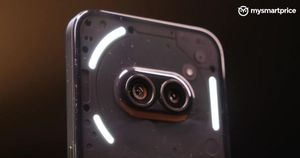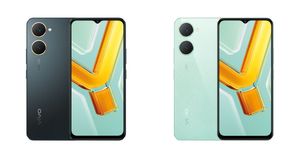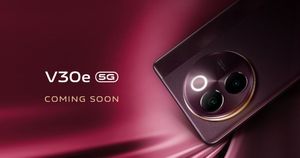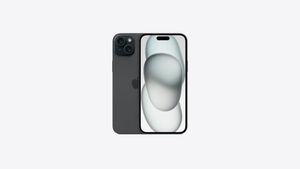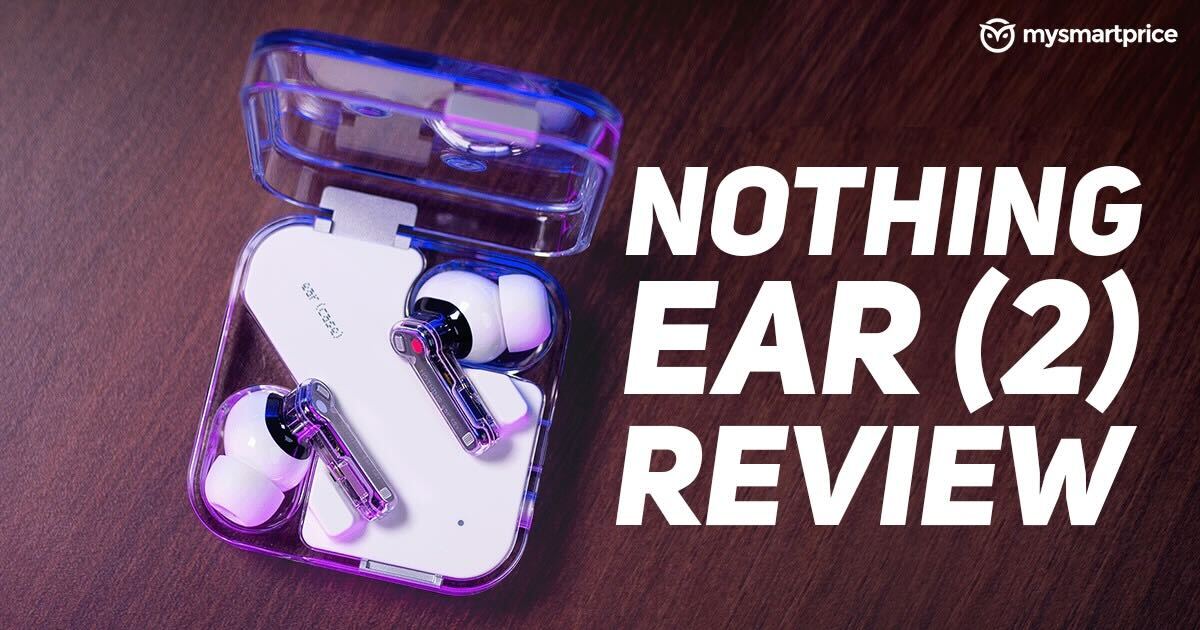
It’s roughly been over two years since Nothing set foot in the market, and the company has already managed to launch four devices — one of which includes a smartphone (that quite literally lights up). While the earbuds market is filled with options, the London-based company broke the monotony with its Ear (1) and took a step forward with its lipstick-style Ear Stick.
Nothing Ear (2)
Rs 9,999What Is Good?
- Compact case and quirky design
- Comfortable for long hours
- Dual connection and LHDC 5.0 support
- IP ratings for earbuds and case
- Personal sound profile
- Better and more detailed sound quality
- Good ANC and microphone
What Is Bad?
- Pricey
- Average battery life
- Unintuitive pinch gestures
- Presets in the app are not useful
Despite the former being plagued with bugs, the earbuds showed promise. To build on that, the Nothing Ear (2) has made its debut with the same design philosophy, witty marketing, custom-made drivers that produce better sound quality, and a bug-free experience. However, all of this comes at a price bump.
The Nothing Ear (2) costs Rs 9,999 in India and is on a mission to continue making tech fun. But is the price bump justifiable? We’ve been using the earphones for over a week, and this is our full review.
Nothing Ear (2) Review: Design and comfort
For years, we have seen the same-old design language for truly wireless earbuds in the market — Nothing has changed that. The Carl Pei-led company hit gold with its design approach for the Ear (1). The only way to top that off would be to light the case up with RGB – almost making it look like a gamers den in your palms. Sadly, that’s a dream we’ll keep for another day. The Nothing Ear (2) follows the same design philosophy with a skeletal and translucent look with minute changes. At first glance, it’s tough to tell apart both.
The case is thinner and more compact this time, making it easier to hold. It comes in the same plastic finish but feels lighter. Besides going through a slimming process, the case also sees subtle changes, such as a smaller dimple on the lid (don’t worry, it’s still a fidget).

With the Ear (1) — the underside of the case was more susceptible to scratches. The Nothing Ear (2) improves on that with two separate indents for the earbuds. It also uses a matte-finished divider running in between which helps keep the scratches at bay. While the bottom part may be safe from scratches, the top still collects many of them.
Despite using the Ear (2) for over a week, we still can’t manage to open the case in the first go — partially because the exposed hinge at the back and magnets on the front look alike —which makes it confusing. Speaking of which, the Ear (1) case lid had a more satisfying thump when compared to the noisier lid on the Ear (2).
It still houses the pairing button and USB-Type C port on the right side. The earbuds sit flush in the case and don’t fall off easily. The case is IP55 rated, while the earbuds are IP54 rated for water and dust resistance. This is an upgrade over the IPX4 rating from last year.
Each earbud weighs 4.5g, compared to 4.7g from last year. Despite the weight reduction, they still managed to include a slightly bigger battery. Visually, there’s no difference when it comes to the earbuds themselves, except for the “Nothing Ear (2)” label etched on the stem. You get the same naked design that lets you have a peek at the inside. The entire body is made of good quality plastic, with the stem painted in black and the shell in white. The earbuds are angled to fit in your ears comfortably.

Speaking of comfort, the Nothing Ear (2) is one of the most comfortable pair of earbuds we’ve worn in a long time. The buds come in an in-ear design which we personally prefer. The default silicone tip sits flush in our ear canal, leaving no room for outside noise. The earbuds passed our yawn, laugh and head shake test. The same test that the Samsung Galaxy Buds 2 Pro couldn’t pass. We wore the earbuds while playing badminton, jogging, and travelling — at no point did we experience any shortcomings. The right earbud still has a red mark, while the left has a white mark to avoid any confusion. Overall, the earbuds feel quite sturdy and premium.

Besides the subtle changes in the design language, the earbuds now have pressure-sensitive controls over the capacitive touch controls from the previous gen. While we are not big fans of the latter, the Nothing Ear (2) might’ve been slightly better with it. The pressure-sensitive buttons are straightforward to trigger. Most of the time, we opted to pick the buds up using the shell and not the stem so that we don’t cut a call or pause the music. While we can make do with everything else, what irked us most were the volume controls. A single swipe upward or downwards would’ve been convenient. The controls can be set in the Nothing X app — more details on that later.
Nothing Ear (2) Review: Audio performance and features
The earbuds use an 11.6mm dynamic driver with custom tweaks. Unlike last time, the earbuds use a combination of polyurethane and graphene materials for the diaphragm, which helps deliver richer sounds. It also uses a dual-chamber design which is usually found in IEMs (in-ear monitors). This helps in better airflow resulting in crisper high-end frequencies — which is quite noticeable when pitted against the Ear (1). These upgrades are commendable, but what’s more welcome is the support for LHDC 5.0, which essentially means you can listen to hi-res audio, provided your smartphone supports it. This codec supports up to 192kHz sampling rates and up to 1Mbps bit rate.

The Ear (2) also supports SBC and AAC codecs but misses out on aptX this time. Sadly, LHDC is not available on every Android device. Even the mighty Samsung Galaxy S23+ doesn’t support it. So, we tried using it on the Nothing Phone (1) (Review) which received an update a while back for LHDC support. While the whole codecs game can be a bit confusing, you need to know that most pop music can also be enjoyed on basic codecs such as SBC and AAC — in fact, the iPhone has support for only these. The earbuds can be quickly connected using Google Fast Pair and Microsoft Swift Pair. It also supports multi-connection, which works flawlessly between devices — Android, iOS or Windows.
The Nothing Ear (2) delivers an energetic and vibrant sound experience with an emphasis on the lower ends. It has a V-shaped sound signature which produces lively bass, especially in songs like Heat Waves by Glass Animals, Pull Up by KSI and JME, and Escapism by 070 Shake and Raye. However, while the earbuds provide clear vocals and detailed highs — it also tends to scare us slightly with the treble in certain tracks, such as Heat Waves, where the snare is quite prominent.

Listening to classics such as Bohemian Rhapsody by Queen was a pleasant experience, with the earbuds focusing on almost all the aspects of the track. The earbuds also provide good instrument separation, which allows them to be quite versatile. Dialogues in movies and TV shows were also clear.
If you prefer a different sound style, the Nothing X app can help you tweak the levels a bit with the equaliser. It also has a bunch of presets such as Balanced, More Bass, which completely overshadows the mids, More Treble, and Voice. We didn’t quite enjoy using these presets, as each of them was flawed in its own way. Balanced was the way to go. The app also lets you take a five-minute test for a custom sound profile. Besides these, the app also has toggles for low lag mode, ANC settings, find my earbuds, dual connection, in-ear detection, and more. The app is brilliantly executed and we love the UI and animations.
Nothing claims that Ear (2) has the “best noise cancellation technology yet” from the company by achieving up to 40 dB of noise reduction. For context, the OnePlus Buds Pro 2 (Review) can achieve up to 48 dB with Adaptive noise cancellation.
The Ear (2) performed well in our usage and managed to silence the ambient noise well. From drowning out the chatter in a canteen filled with people ready for office gossip to the busy roads of Delhi, the earbuds proved their mettle. The app has three different ANC modes at your mercy: Noise cancellation, Transparency, and off. You can set the level from High to Adaptive as per your preference.
The earbuds also have a total of six microphones, three on each earbud. The call quality was also good, with a crisp voice and minimal background noise.
To understand the sound of the Nothing Ear (2) more, we compared it with some counterparts. Starting with the Nothing Ear (1), the sound is somewhat similar, with the newer generation being more focussed on, the lower end with a spacious sounding profile thanks to the dual chamber design. While the fit and comfort are along the same lines, ANC is slightly better on the Ear (2).

Pitting this against the OnePlus Buds 2 Pro really got our heads spinning. Both have a similar sound signature, with the OnePlus heavily focusing on the treble and overshadowing the mids. The OnePlus Buds Pro 2 uses 11mm woofers + 6mm tweeter dual drivers. We also found the Nothing Ear (2) to be more comfortable in our ears. As for the case, the Buds 2 Pro has a wider case which is almost impossible to open using a single hand without performing thumb acrobatics – such is not the case (no pun intended) with the Ear (2).
As for the inevitable comparison with the Apple AirPods (3rd Generation), the Nothing Ear (2) had a better fit and better ANC (silicone tips play a small role). On the other hand, the AirPods deliver solid and balanced sound with less emphasis on the bass.
Nothing Ear (2) Review: Battery life and charging
The Nothing Ear (2) boasts 36 hours of music playback (ANC off) with the case and 6.3 hours with the earbuds alone. The case packs in a 485mAh battery, with the earbuds each carrying 33mAh — which is a slight upgrade from last year.
We spent most of our time on the earbuds with noise cancellation enabled. And, to summarise, the battery life was not really up to the mark. With ANC on, we barely managed to binge-watch John Wick 2 and John Wick 3: Parabellum before the buds had to be put to bed. While listening to music and switching between two devices, the earbuds lasted us a maximum of four hours. This is a recurring issue from the Ear (1). The OnePlus Buds Pro 2, in comparison, managed to last for seven hours with ANC turned on during our tests.

We also noticed some disparity between the two earbuds, as the right bud was always 10 per cent lower than the left.
Besides that, the earbuds have a sound prompt for low battery, which startled us for the first few times because of its high volume. The case barely takes 40 minutes to charge fully from dead using a standard 20W PD charger. It also supports wireless charging (up to 2.5W) and reverse wireless charging.
Nothing Ear (2) Review: Verdict
With a starting price of Rs 9,999, Nothing Ear (2) has climbed up the ladder of cost. Unfortunately, this means it cannot be pitted against its budget counterparts but instead with premium options such as the OnePlus Buds Pro 2, Oppo Enco X, Google Pixel Buds A, and more. All of which have different design approaches and soundstages.
The company created a winning formula with its transparent design. Now, with minor refinements and sculpting — the Ear (2) is a much better version of the Ear (1). The custom-made drivers deliver lively and detailed audio. The integration of LHDC 5.0 and support for dual connection are much welcome features. The Nothing X app has enough customisations, but the presets are unusable in their current form. The ANC has improved slightly, but the battery is still a chink in its armour. IP rating for both the earbuds and case is a commendable addition.








